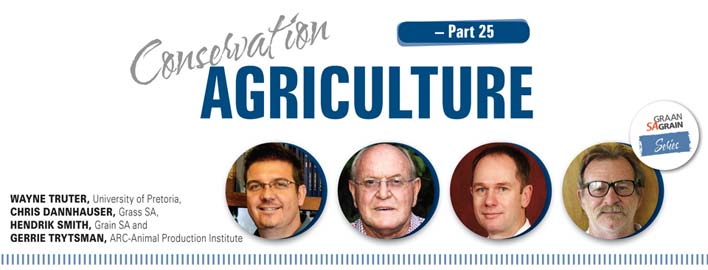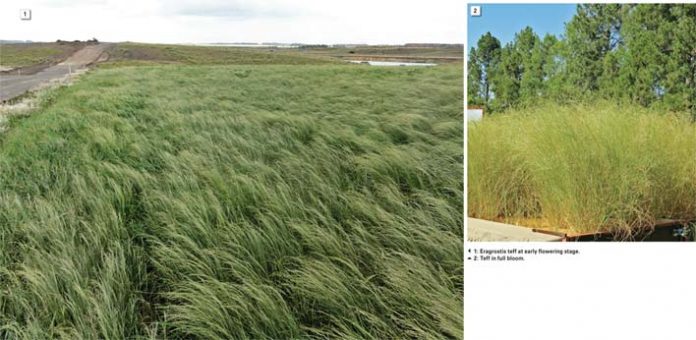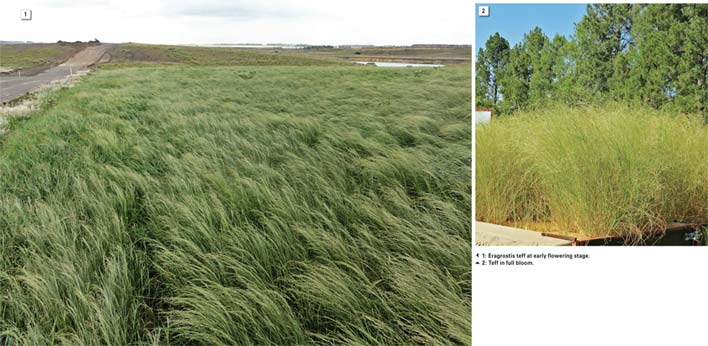April 2016

WAYNE TRUTER, University of Pretoria,
CHRIS DANNHAUSER, Grass SA,
HENDRIK SMITH, Grain SA and
GERRIE TRYTSMAN, ARC-Animal Production Institute
Integrated crop and pasture-based livestock production systems
This article is the 25th of a series of articles highlighting a specific crop species that can play an imperative role in conservation agriculture (CA)-based crop-pasture rotations.
Besides improving the physical, chemical, hydrological and biological properties of the soil, such species, including annual or perennial cover crops, can successfully be used as animal feed.
Livestock production systems are in many ways dependent on the utilisation of forage species, in this case as an annual cover crop, and can therefore become an integral component of CA-based crop pasture rotations. It is imperative to identify a plant species fulfilling the requirements of a dual purpose crop, i.e. for livestock fodder and/or soil restoration.
This article focuses on an annual summer grass cover crop with the potential to be used to improve soil conditions and to provide high quality fodder for ruminants and horses.
Eragrostis teff, teff or tef
Teff originates in Ethiopia and is an annual scantly tufted grass that can grow to 1 m tall. Teff is a very leafy plant and has a high yield of grain when in seed. This is a C4 plant and uses light efficiently in low moisture conditions.
It is also a shallow-rooted grass and has the ability to establish quickly in many different soil types. There are many different types of teff with three main types of seed colour. The white teff is slow maturing, grows in cooler conditions and is superior for grain production. Red and brown teff are faster maturing grasses and are superior for fodder. Because of its good nutritional qualities, teff is most commonly produced as a hay crop in South Africa.
Agro-ecological distribution
Teff requires an average rainfall of as low as 350 mm per annum, and the grain teff can grow with rainfall as high as 2 500 mm per annum. This species resists moderate droughts, hot weather, poor soil and low fertility.
Most cultivars require at least three good rain showers during the early growth and a total of 200 mm to 300 mm of water. Most teff in South Africa is grown in areas that receive between 400 mm to 900 mm rainfall. White teff has the ability to tolerate some frost; however it will not survive prolonged periods of extremely cold temperatures. On the other hand teff can also tolerate high temperatures of 35°C and higher.
With regards to soil types, teff is adapted to a variety of soil types and can be grown on sand to turf soils. It should be noted that even though teff grows on clayey soils, such as black turf soil, it does not tolerate waterlogged conditions. It is therefore essential that the soils in higher rainfall areas should be well-drained for optimal teff production. From a soil chemical perspective, soils with a pH lower than 5 will not significantly affect the growth of teff, thus making this species acid soil tolerant.
Management and utilisation
Since teff is a crop mainly grown for hay production, it is extremely important to ensure a firm, fine seedbed for the very small seeds sown. Consequently a level and uniform seedbed is required which will facilitate an easier hay harvesting process. When planting teff, it is essential to consolidate (roll) the seedbed before and after seeding. It is also important to make sure that the soil fertility levels are up to standard, especially the phosphorus (P) and potassium (K) levels being at least 15 mg/kg soil and 100 mg/kg soil, respectively.
Once the teff has germinated, the pasture can be fertilised twice during the growing season with two applications of 50 kg N/ha. If too much nitrogen is applied, this can result in the lodging of the species which results in difficult harvesting and significant loss of dry matter (DM) yield.
When planning on seeding teff, it is important to take note of whether it is being planted with other perennial sub-tropical grasses, such as Eragrostis curvula (weeping love grass/oulandsgras) – which is a common practice, or on its own, as this determines the seeding rate.
Teff is usually planted in early summer and can then provide at least two harvests. However, when planted mid-summer one harvest is usually obtained. The sowing rate for sandier soils is 7 kg/ha to 10 kg/ha and for clayey soils 10 kg/ha to 15 kg/ha and should be planted between mid-October and mid-January.
Teff is often used as a ‘nurse crop’ for many perennial pasture crops, and is quite commonly used in a mixture with Rhodes grass and Smuts finger grass.
When teff is seeded with these other species, the ratio of teff to other species is important, as the teff can smother the other species if not managed correctly. It is therefore important to lower the seeding rates of teff to 5 kg/ha to 8 kg/ha depending on soil type (sandier versus clayey) and rainfall (low to high).
Soil conservation and health benefits
Teff is becoming more and more attractive as a temporary nonweedy ground cover in many parts of the world. Its function as a temporary ground cover due to its quick establishment and competiveness with other weeds has made this species an extremely important crop in the rehabilitation of degraded and disturbed soils.
As previously mentioned, teff is quick to establish and this becomes an extremely important characteristic of a pasture ley or cover crop which addresses the threat of erodible soils. Since teff has a shallow root system it therefore has the ability to stabilise the soil surface and not deplete the soil moisture and nutrient levels at deeper levels. As teff is currently being used as a ‘nurse crop’ it has the function of creating a micro-climate at the soil surface, thereby lowering the soil temperature which facilitates the germination of the more perennial species, but also preventing significant moisture loss through lowered evaporation at the soil surface.
Management challenges
The small size of teff seed poses problems during sowing and indirectly during weeding and threshing. At sowing the very small seed size makes it difficult to control population density and its distribution. The uneven plant stand after germination has an impact on nutrient use efficiency of the crop and crop yield.
Teff is not recommended for grazing purposes, since much plant material is lost due to trampling by grazing animals. It is also not suitable for silage and even less for foggage as reasoned in the latter statement.
Teff is therefore an extremely important hay crop and can provide high quality fodder. Harvesting of the crop is difficult because of lodging. Since teff lodges heavily it is not advisable to use higher rates of fertiliser to increase yield.
Teff rust (Uromyces eragrustidis Tracy) and head smudge (Helminthosporium miyakei Nisikado) have been reported as the most important diseases on teff (Stewart and Dagnachew, 1967 and Tareke, 1981).
Damping-off caused by Drechslera poae (Baudis) Shoemaker has been found to be severe and even damaging when higher rather than lower seed rates and early rather than late sowing dates were practised (Ketema 1997). Other insect pests have also been reported and include Welo bush-cricket (Decticoides brevipennis Ragge), central shootfly (Hylemya arambourgi) and the red teff worm (Mentaxya ignicollis Walker) (Ketema, 1997).
Animal production aspects
Teff is known as a very good quality hay crop. It is ready for hay making within 65 days to 75 days. For the best results it should be cut during the early to mid-flowering stage. It can produce between 2 tons DM/ha to 8 tons DM/ha, depending on all the climatic and management factors. Some producers have been successful in irrigating teff pastures and can produce up to 12 tons of DM per hectare. This grass is often used in the equine industry due to its high quality. With regards to the forage quality of teff, it is reported that it can have crude protein levels as high as 11% and as low as 6%. Teff has a crude fibre content of between 27% to 35% and a digestibility of 55% to 60%.
Conclusion
Considering the role of pasture ley and cover cropping systems in conservation agriculture, as an annual short-season crop and a plant that grows best during the hot summer months, teff can be used as an ‘emergency’ forage crop in the event of delayed planting, poor stands, or winter kill of another crop.
As a short season ley crop, teff can provide a good weed competitive ground cover to protect the soil from soil erosion especially in a dry season, which teff is tolerable of. With its shallow root system and low fertility demands, it is more preferable to have teff grow in a rested land than undesirable weed species that contributes future weed seed to the seed bank.
References
Dickinson, EB, Hyam, GFS, Breytenbach, WAS, Metcalf, WD, Basson, WD, Williams, FR, Scheepers LJ, Plint, AP, Smith, HRH, Smith, PJ, Van Vuuren, PJ, Viljoen, JH, Archibald, KP and Els, JN. 2004. Kynoch Pasture handbook. Kejafa Knowledge Works: Maanhaarrand.
Ketema, S. 1997. Tef, Eragrostis tef (Zucc.) Trotter. ISBN 92-9043-304-3. Biodiversity Institute: Addis Abeba, Ethiopia, IPGRI.
Stewart, RB and Dagnachew, Y. 1967. Index of plant diseases in Ethiopia. Experiment Station Bulletin No. 30. Alemaya University of Agriculture: Dire Dawa, Ethiopia.
Tareke, B. 1981. Inheritance of lemma colour, seed colour and panicle form among four cultivars of Eragrostis tef (Zucc.), Trotter. PhD Thesis, University of Nebraska: Lincoln, USA.
Publication: April 2016
Section: On farm level



















